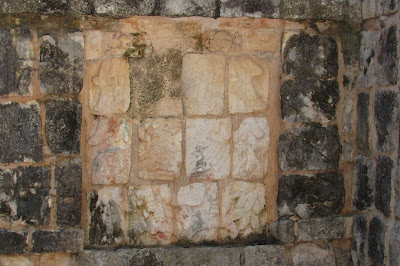Cancun is a tourist meca with over 20 km of resorts lining the beaches along a narrow strip of land separating mangrove swamps and lagoons from the Caribbean Sea. We stayed at the Hotel Sotovento, a low coast alternative from the expensive all-inclusive properties at only $35 CDN per night. The hotel was located towards the middle of the strip. Though quite basic, staff were friendly and it featured a small outdoor pool, clean rooms and hot breakfast included.
There are many different daily tours available to Chichen Itza. We chose a day trip in a small 12 passenger van, through VIATOUR, which included an early morning pick up from the hotel. While taking the two hour drive to Chichen Itza our friendly, English speaking Mayan archeologist guide educated us about Mayan culture and the intricacies of the counting system they developed hundreds of years before any contact with ‘civilized’ man.
Graphic stone carvings survive at structures like the ball court, Temple of the Warriors and the Wall of the Skulls. The Mayans were an ingenious people; these structures are remarkable!
We even stood where ritual sacrifices took place. They sacrificed both animals and humans. Our expert guide explained that young maidens were often chosen as human sacrifices in order to advance their family’s fortune and status in the Mayan culture. The victims were sometimes laden in gold, silver and precious stones before being hurled into the Sacred Cenote, a 100 foot deep pool of water. Cenotes are natural formations, resulting from the collapse of limestone bedrock that exposes groundwater underneath.
Before our trip back to Cancun we enjoyed a short Planetarium experience, which gave us a better understanding of how important stars and astronomy were to the Mayan culture.
We may never be back but we will always remember this wonderful day where we learned so much about the Mayans at Chichen Itza.
Tricia and Jim Bowen
S/V Falcon VII - land cruise to Cuba
email: tandjbowen13@gmail.com










Hi, been there but you should see Talum also. god bless - ross
ReplyDelete